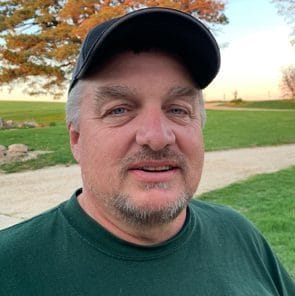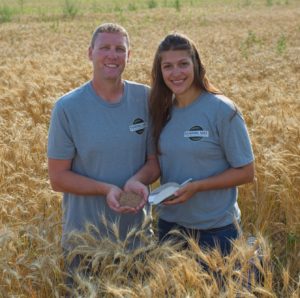Help grow the power of the PFI community. Donate today.
Shared Learning Calls
Join Us for Small Grains Shared Learning Calls
Small grains shared learning calls are conference calls where you can listen and talk with other farmers and small grains enthusiasts. Each month our speaker(s) share experiences and production practices for 40 minutes, and then we open the floor for questions and discussion. Shared learning calls usually take place on the first Friday of the month from noon-1 p.m.
We use Zoom to host these virtual events. To participate in shared learning calls, you can either join by phone or computer.
Receive reminders about future shared learning calls and get resources on small grain production delivered straight to your inbox by signing up for our monthly Small Grains News newsletter.
Schedule
July 11 | Noon-1 p.m.
Grazing a Summer Cover Crop Mix Following Small Grains
One of the greatest benefits of small grains in a rotation is the opportunity to plant a multi-species cover crop mix following harvest. This is especially helpful for livestock farmers trying to avoid the “summer slump” when their livestock have little available fresh forage. Rick Matt is one such farmer who has capitalized on the soil health and nutritional opportunities that small grains offer, rotationally grazing at various points between small grain harvest and the following year’s corn planting. Tune into the July shared learning call to hear Rick’s insights on how to choose complementary cover crop species and the different benefits each species has for the farm, including forage. He’ll share how small grains continue to find their place, in reciprocity with livestock, in his farm’s rotations.
 Rick Matt of Varykino, Inc. farms with his son Damien in northeast Iowa where they have gradually incorporated regenerative practices. They started out with no-till in 1993 and added cover crops three years later. In 2018, they started growing summer cover crop mixes of eight or more species. Primarily a beef operation, the Matts added sheep to the farm a couple years ago and graze both extensively on warm and cool season cover crops noting the additional benefit the manure offers to the soil.
Rick Matt of Varykino, Inc. farms with his son Damien in northeast Iowa where they have gradually incorporated regenerative practices. They started out with no-till in 1993 and added cover crops three years later. In 2018, they started growing summer cover crop mixes of eight or more species. Primarily a beef operation, the Matts added sheep to the farm a couple years ago and graze both extensively on warm and cool season cover crops noting the additional benefit the manure offers to the soil.
Aug. 1 | Noon – 1 p.m.
Getting Started with On-Farm Grain Milling
Though they had grown wheat for years, Peter and Brittany Haugen had never heard of Einkorn and Emmer, two ancient wheat varieties, until their seed dealer introduced them in 2021 amidst their organic transition. They quickly learned that flour from those grains was desirable to many people in their area but had no outlet in western Minnesota. Always excited to think and act outside the box and having a desire to bake using their own grains, the Haugens took a leap; they bought a stone mill and started Sandhill Mill that same year.
 Attend their shared learning call to hear what they’ve learned about opening and running a mill, choosing grains to grow and mill and marketing products locally. They’ll share about the other grains and wheat varieties they’ve added to their rotations, explain how stone milled flours differ from most flours found at grocery stores and push others to be creative when making decisions about farm practices and marketing strategies.
Attend their shared learning call to hear what they’ve learned about opening and running a mill, choosing grains to grow and mill and marketing products locally. They’ll share about the other grains and wheat varieties they’ve added to their rotations, explain how stone milled flours differ from most flours found at grocery stores and push others to be creative when making decisions about farm practices and marketing strategies.
Upcoming dates
- Sept. 5, 2025
- Dec. 5, 2025
Share Your Ideas for Future Calls
Shared learning calls are a staple of PFI’s small grains programming. We would love to hear your feedback on previous calls and what topics or speakers you’d like to learn from in 2025 and beyond.
If you have feedback to share about previous calls you attended or have ideas for future calls, please fill out this short form to share your thoughts so we can aim to better tailor upcoming calls to your interests.
Blog Recaps
Most shared learning calls are followed up with a blog recap. Read through our recent shared learning call recap blogs to see what you missed:
- Equipment for Planting Cover Crops and Frost Seeding
- Unlocking the Potential of the Soil: Boosting Forage Nutrition With Extended Rotations
- Getting Started with Kernza: Top Tips for Planting, Harvesting and Marketing
- Research Connects Soil Health Principles, Ecosystem Services and Climate Resiliency to Extended Rotations
- Incorporating Oats in Extended Rotations
- Feeding, Grazing and Growing Nitrogen With Red Clover
- Incorporating Small Grains in Livestock Rations to Achieve Regenerative Agriculture Goals
- The “Why” of Winter Barley, Plus 4 Tips on Winter Barley Double Cropping
- Making the Most of Winter Grains in an Extended Rotation
- Observations on Summer Crops, Small Grains and Grazing Covers
There’s plenty more than just the handful of blogs listed above! Check out the latest small grains resources.
Acknowledgements
This material is based upon work supported by the U.S. Department of Agriculture and National Fish and Wildlife Foundation, under grant ID 2004.22.075401 and agreement number 75401.
Any opinions, findings, conclusions, or recommendations expressed in this publication are those of the author(s) and do not necessarily reflect the views of the U.S. Department of Agriculture. In addition, any reference to specific grants or types of products or services does not constitute or imply an endorsement by the U.S. Department of Agriculture for those products or services.
This project is also made possible through a grant from the National Fish and Wildlife Foundation, with support from ADM re:generations.
